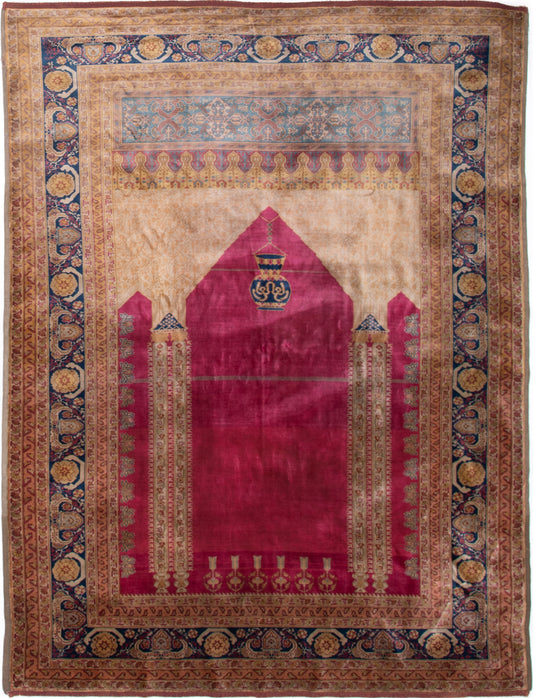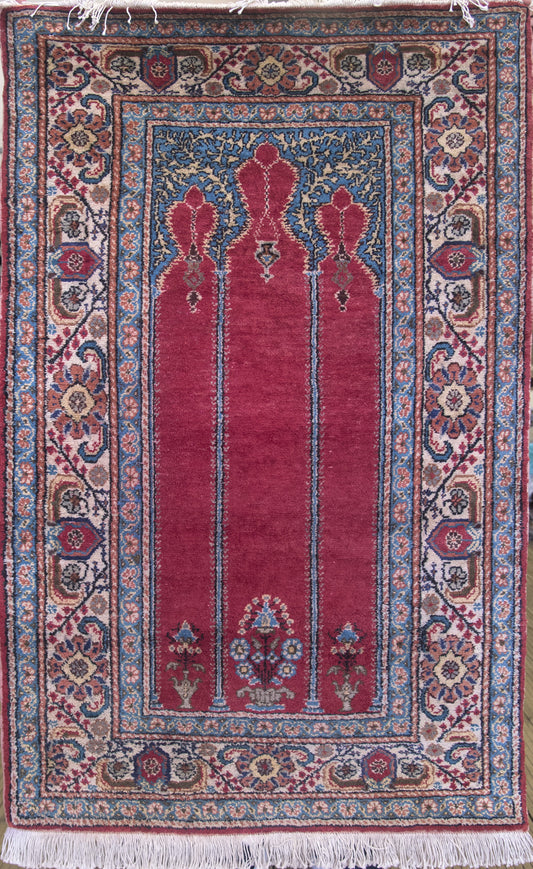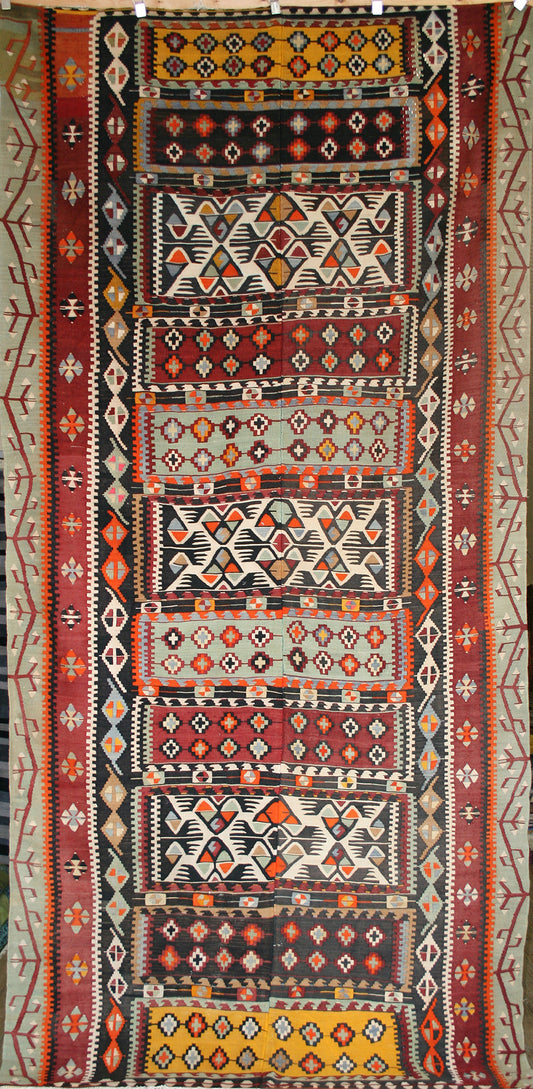Konya Rug History & Origin Guide
Introduction
Konya rugs have an illustrious history that can be traced back to Marco Polo's writings in 1292, where he described them as the world's most beautiful rugs.
Originating in the Konya region, one of Asia Minor's oldest and largest continuously inhabited cities, these rugs gained prominence when the Seljuk Sultans of Rum established their capital in the area.
Several large carpets from Konya were discovered in the early 20th century in the Alaadin Mosque and are now displayed in the Museum of Turkish and Islamic Arts in Istanbul. Konya rugs are highly sought after by scholars and collectors for their bold tribal designs, stunning colour combinations, and rarity.
History of Konya Rugs
As one of the oldest continuously inhabited cities in the world, Konya has a rich history in carpet weaving, dating back to the Seljuk era in the 13th century. Under the patronage of the Seljuks, carpet weaving in Konya flourished, incorporating Persian and Byzantine influences. When the Ottomans conquered the region in the 15th century, the art of rug weaving continued to thrive, and Konya gained a reputation for producing some of the finest carpets in the Ottoman Empire.
Konya rugs gained international recognition when they were exhibited at the 1893 World's Columbian Exposition in Chicago, further solidifying their status as masterpieces of textile art.
Classification of Konya Rugs
Today's Konya rugs encompass those produced in the surrounding regions, including Kecimuhsine, Karapinar, Obruk, and Taspinar. All these areas are part of "Greater Konya", and distinctions can be made between different types. Nomadic rugs from the Konya region are also known as Yörüks. In many ways, Konya rugs can be considered the Turkish equivalents of Caucasian Kazakhs, though they are generally older, rarer, and just as sought after by collectors.
Design and Patterns of Konya Rugs
Traditional Motifs
Konya rugs are celebrated for their bold, geometric designs and striking colour palettes. Typical motifs include medallions, stylised flowers, stars, and other geometric patterns. Konya rugs often feature a central medallion or a series of interconnected medallions, surrounded by intricate borders that showcase the weaver's skill. The borders often include a combination of smaller geometric and floral elements, creating a harmonious balance between the central field and the surrounding patterns.
One common geometric motif is the "Memling gul", a geometric medallion pattern found throughout the carpet. Konya rugs also exhibit a fairly loose knotting technique.
Symbolism
Many Konya rug motifs carry symbolic meaning, rooted in the beliefs and traditions of the region. For instance, the 'elibelinde' symbol represents fertility and motherhood, while the 'cengel' motif symbolises protection and strength. These symbols, passed down through generations, give Konya rugs a deeper cultural significance beyond their aesthetic appeal.
Colour Palette
The traditional colour palette of Konya rugs includes rich reds, deep blues, and warm yellows, often contrasted with ivory or white. These vibrant colours are obtained from natural dyes derived from plants and insects, such as madder root, indigo, and cochineal, resulting in a remarkable depth and intensity that remains vibrant for generations.
Older Konya rugs are characterised by their restrained colour combinations and use of earth tones, such as soft yellows, terracotta, and browns. A unique feature of Konya rugs is their red wefts, setting them apart from other Persian carpets.
Materials and Production Techniques
Konya rugs are hand-knotted using high-quality wool from local sheep, providing a soft and durable pile. In some cases, silk or cotton may be used for the foundation of the rug, adding further strength and flexibility. The knotting technique used in Konya rugs is the symmetrical or Turkish knot, known for its durability and resistance to wear.
The nomadic pieces within this genre often have a dark wool or goat hair foundation.
These rugs generally have a lower knot density compared to Persian rugs, but their robust construction and high-quality materials ensure their lasting appeal. Each rug is a unique expression of the weaver's artistry and skill, with no two pieces being identical.
Modern Konya Rug Production
In recent years, the production of Konya rugs has seen a resurgence, with both traditional and contemporary designs being produced. Modern Konya rugs often reinterpret classic motifs with updated colour palettes and patterns, appealing to a wide range of tastes and interiors. In addition to the traditional wool Konya rugs, some contemporary pieces also incorporate silk and other luxury materials for added texture and visual interest. Despite these modern adaptations, the spirit and essence of Konya rug craftsmanship remain true to their roots, celebrating the region's rich history and tradition.
Collecting and Caring for Konya Rugs
Due to their historical significance, distinctive designs, and high-quality craftsmanship, Konya rugs are highly sought after by collectors and enthusiasts alike. When purchasing a Konya rug, it is essential to consider factors such as age, condition, and provenance to ensure authenticity and value.
Proper care and maintenance are crucial for preserving the beauty and longevity of Konya rugs. Regular vacuuming, rotating, and professional cleaning can help maintain their vibrant colours and intricate patterns. By following these guidelines, Konya rugs can be cherished and enjoyed for generations to come.
Visiting Konya
Konya, a city steeped in history, offers visitors an opportunity to explore its rich cultural heritage. Highlights include the Alaadin Mosque, where several large Konya carpets were discovered, and the Museum of Turkish and Islamic Arts in Istanbul, where these carpets are now displayed. The city's ancient history, combined with its modern attractions, make Konya an interesting and vibrant destination for rug enthusiasts and travellers alike.
Climate and Best Time to Visit Konya
Konya experiences a continental climate with cold, snowy winters and hot, dry summers. The city's climate can greatly influence the quality of the wool used in rug production. Sheep raised in the rural areas surrounding Konya are known for producing rich, lustrous wool, particularly during the colder months when their coats grow thicker to protect them from the harsh weather.
The best time to visit Konya is during the spring (April to June) and autumn (September to November) months when the weather is mild, and the city is in full bloom. These seasons provide comfortable temperatures for exploring the city and its cultural attractions, such as the Alaadin Mosque and the Museum of Turkish and Islamic Arts.
The favourable weather conditions during these periods also make it an ideal time to appreciate the vibrant colours and intricate designs of Konya rugs. The mild climate allows for better dye absorption, resulting in more vivid and long-lasting colours in the carpets. Additionally, the cooler temperatures are perfect for the local sheep to produce high-quality wool, which translates to softer, more luxurious rugs.
Conclusion
Konya rugs are a testament to the rich cultural heritage and exceptional craftsmanship of Central Anatolia. With their bold geometric patterns, vibrant colours, and durable construction, these rugs are a true representation of the region's longstanding rug weaving tradition. Whether displayed as a stunning focal point in a room or collected as a prized piece of textile art, Konya rugs continue to captivate and inspire appreciation for their unique beauty and storied history.
Browse Our Current Selection of Konya Rugs
-
Antique Turkish Konya Rug
Regular price £6,975.00Regular priceUnit price per -
Semi-Antique Turkish Konya Rug
Regular price £725.00Regular priceUnit price per -
Semi-Antique Turkish Konya Kilim Rug
Regular price £2,995.00Regular priceUnit price per



